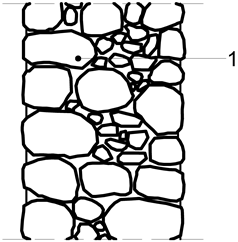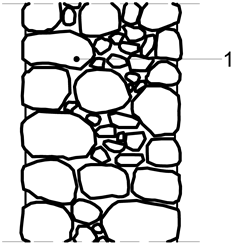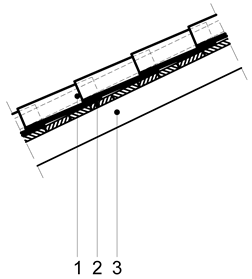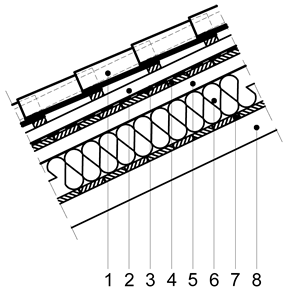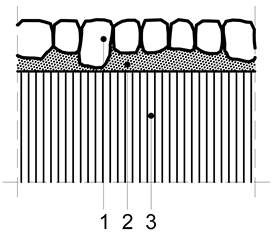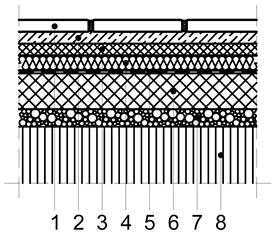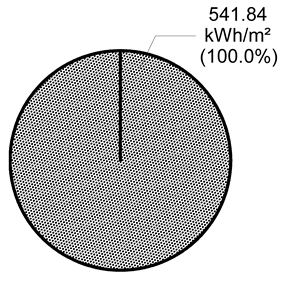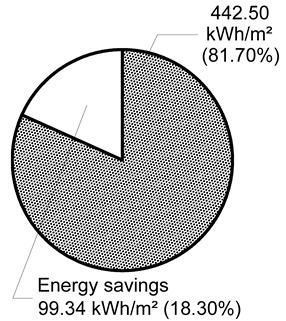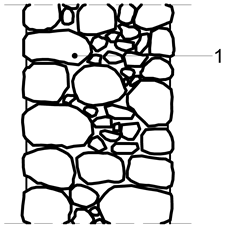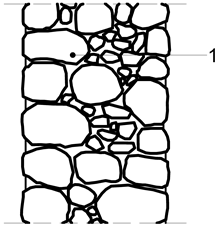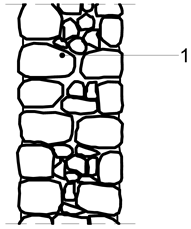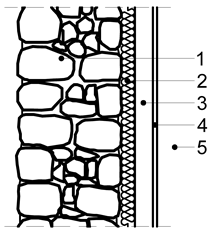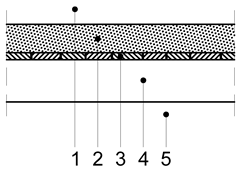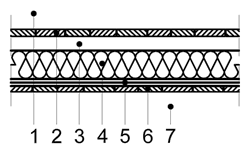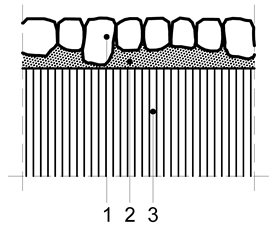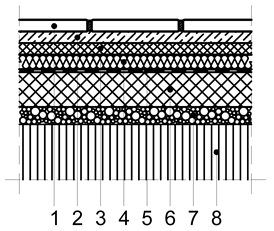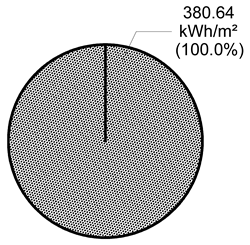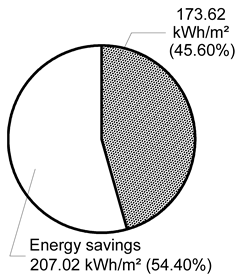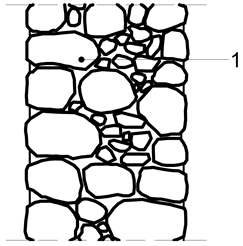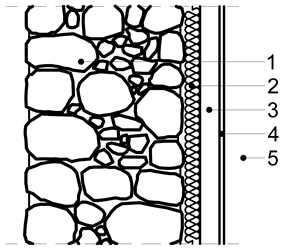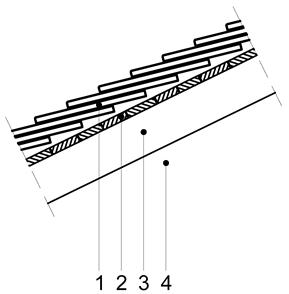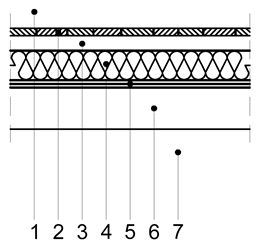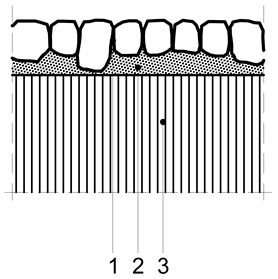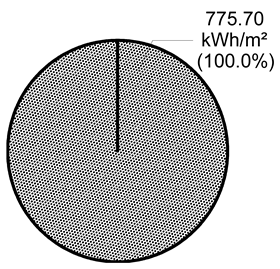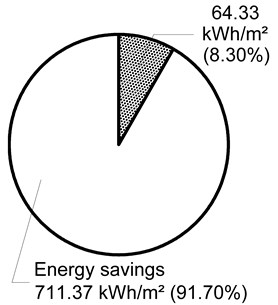Abstract
This study deals with the integrated process of conservation and restoration of architectural heritage and sustainability. The objective of the research was to define adequate methodologies for the structural restoration of historic buildings, their re-use, and sustainable refurbishment in accordance with modern requirements and conservation standards while maintaining the original visual character by using natural stone as an authentic building material. The main research method was the in-situ observation of the historic structures during the restoration and adaptive re-use, the analysis, and evaluation of the research findings regarding energy efficiency improvements and energy saving in the Haybarn complex within the monastery Hilandar, Mount Athos, Greece. Due to its cultural and natural values, Mount Athos has been inscribed on the UNESCO World Heritage List. The research included the damaged and abandoned agricultural structures that belong to the Haybarn complex and the analysis of the obtained results after the restoration had finished and the abandoned premises had been turned into guest rooms for the visitors of Hilandar monastery. The result section states the findings of the research arranged as recommendations for historic building restoration and re-use, emphasizing their new function in accordance with modern comfort requirements and environmental protection standards. The main contribution of this study is the analysis of the research findings and the possibilities of energy refurbishment of the restored historic buildings, through the use of natural stone as authentic local construction material, in accordance with energy efficiency measures and principles, conservation requirements and cultural heritage conservation standards.
1. Introduction and Premises
The cultural value of heritage buildings is our legacy that we will pass on to our future generation. However, it is evident that not all heritage buildings still function with their original use, which means for these cases a new function is required so that we could preserve the intrinsic value of heritage buildings [1].
Adaptive re-use of old, damaged and restored historic buildings ensures environmental benefits and revival of dilapidated buildings in order to follow modern trends and architectural, functional and economic values [2]. Nowadays, the process of retrofitting a great number of old buildings, such as churches, public facilities, industrial facilities or agricultural buildings, for new functions, is carried out in accordance with the current needs and adaptive re-use requirements, ensuring the preservation of these architectural structures from destruction. Restoration and revitalization turn the abandoned and demolished historic buildings into new business premises, galleries, alternative theaters, commercial buildings, hotels, tourist accommodation facilities, and so on.
In the past, construction workers would use local materials, natural light and ventilation and optimal orientation of a building in order to take advantage of natural sources of heat energy, in accordance with bioclimatic factors. Therefore, they were implementing the principles of environmental and energy efficient construction of that period. The construction of buildings used to be carried out in accordance with bioclimatic design—specific resilience of architectural structures, the durability of local construction materials, the abundance of greenery and free land space around the buildings. After hundreds of thousands of years, the environmental endurance and durability of these construction materials testified on their sustainability [3,4].
Restoration and re-use of a historic building, energy-save refurbishment measures and the use of stone as authentic local material, represents one of the main conditions of the successful revival of the existing building. Construction materials and any performed additions have to be in harmony with the original structure. When it comes to interventions, they also need to be carried out without harming the quality impartment and integrity of the building itself. The new function of the restored building must complement its space requirements [5].
This study deals with the restoration and adaptive re-use of the abandoned buildings within the Haybarn complex on Mount Athos, in Greece, in order to improve the energy performance, to contribute to environmental protection and to maintain the authenticity of these buildings. The use of stone as the main building material on Mount Athos is a consequence of its availability and easy extraction. Stone is a natural material extracted from natural deposits called quarrying. Stone needs very little maintenance, and after a simple method of stone processing, it is turned into construction material. Building stones were widely used in the Middle Ages for massive foundations, walls, domes or vaults. Several types of stone were used for decorative facade ornaments, the interior design of these buildings as well as for indoor flooring. Natural stone slabs, used as a roofing material, were almost untreated (Figure 1A). This stone roofing technique still stands in some Mount Athos buildings. Numerous structures within the monastery complex of Hilandar were covered with stone slabs: mansions, towers, churches and chapels [6].
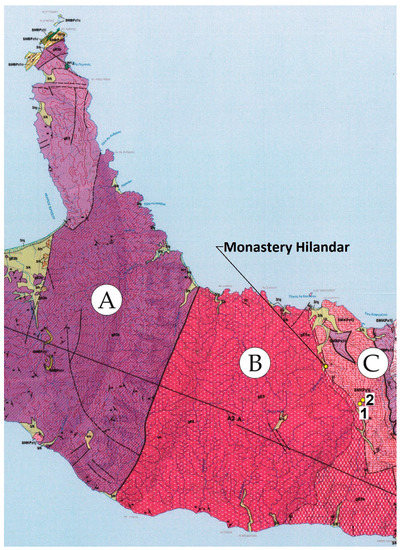
Figure 1.
The geological map of the property of the Hilandar Monastery [23]: (A): Rocks of granite group, (B): Rocks of gneiss group, (C): Rocks of ophiolitic mélange group; 1. 2—places where sample 1 and sample 2 were taken.
The use of natural stone extracted from a local quarry maintains the authentic architectural value of facades. Natural stone has a direct influence on the technical and aesthetical aspects of the restored historic buildings. Appropriate extractions from historical stone quarries reoccur in remote and isolated areas, such as Mount Athos. Inaccessibility and isolation of the Athos peninsula enabled the long-term conservation of natural stone resources in these historic quarries of Mount Athos. The extraction of stone, from the same quarries from which the extraction had been carried out a few centuries ago for the purpose of the construction of the buildings, which had been included in the restoration and revitalization process described in this study, has a great positive value for heritage conservation. The exploitation of stone from these historical quarries and the use of the same type of stone contributes to the appropriate restoration of heritage buildings. It also prevents potential negative aspects regarding durability and endurance, thus enabling the conservation of architectural heritage.
The new function of the restored building should ensure a significant financial gain so that the future maintenance of the building is provided for. A successfully realized adaptive re-use increases the value of the property and might also contribute to cultural tourism. The physical survival of heritage buildings is not enough—these buildings are to be economically sustainable as well [5].
When it comes to contemporary conservation theory and practice, adaptive re-use is regarded as a significant and qualitative approach to cultural heritage conservation [7]. Cultural, social and economic benefits of a community significantly depend on architectural heritage conservation. Therefore, a new function of the building should be the most appropriate and useful one, in order to ensure the preservation of the cultural significance of the heritage building. Numerous factors contribute to the selection of a new destination for the heritage buildings. All the aspects and factors must be detailed and considered for a sustainable re-use following an adaptive project [1].
The concept of the energy refurbishment of heritage buildings is not different from the concept meant for the buildings that are not inscribed in the heritage list. Energy refurbishment methods depend on cultural heritage aspects and the selection of a new function of historic buildings. Before the beginning of any restoration, all current conditions and characteristics of a historic building should be assessed in order to choose the most appropriate method of energy efficiency improvement. These energy improvement measures should include potential energy savings as well as the preservation of materials and features of a historic property [4]. Optimal energy refurbishment of historic buildings must take into consideration the existing energy aspects of the historic construction in order to preserve them for further efficient use, along with new measures aimed to improve energy performance.
Historic buildings are heterogeneous and preserved in different ways. So far, general recommendations for a minimum quality level of energy efficiency improvement in historic buildings have not been defined on a large scale [4].
Restoration of historic buildings and energy efficiency measures should be planned and carried out carefully, avoiding potential negative impacts on the historic character and integrity of the restored buildings. Ongoing monitoring of the restored buildings detects unexpected changes or defects, as a consequence of the restoration. Instantaneous measures for problem removal prevent irreparable damage to historic materials. These measures, along with regular maintenance, ensure the long-term preservation of our historic built environment and sustainable use of construction materials resources [4,8].
Preserving the authenticity is one of the basic concepts of most conservation requirements and the authenticity maintaining is the overall goal of heritage conservation. The concept of authenticity (The Nara Document on Authenticity) [9] is fundamentally significant for cultural heritage research, conservation measures and World Heritage List criteria selection. The Nara Document on Authenticity, formulated in 1994, defines the main aspects and assessment of authenticity [9]. The preservation of architectural heritage, the authenticity of heritage buildings, their original and new functions, comfort improvements as part of restoration and energy savings ensure a sustainable model. Sustainability and restoration of historic buildings are inseparable and interdependent.
Knowing that keeping of the authenticity maintenance and the cultural heritage preservation are significant aspects of any restoration of historic buildings, the retrofitting is mostly performed in the interior of the building while maintaining all of its original exterior wall elements [10]. A building envelope is the physical separator between the conditioned and unconditioned environment of a building including the resistance to water, air, light, heat and noise transfer.
The thermal insulation of the external wall, part of the building envelope, should be avoided since the loss of the authenticity is incomparable in its importance with an insignificant energy saving. In this way, not only the visual appearance of historic buildings are protected, but also the construction system itself [11].
The cooling and heating of historic buildings without appropriate thermal insulation requires additional energy, which increases energy costs for using and maintaining that building. It also leads to increased environmental pollution. The existence of cold peripheral space of a building, such walls and attics, which are uninsulated or inadequately insulated, is responsible for: increased heat loss in the winter months, structural defects due to condensation from within the structure or overheating in the summer months. Poor condensation control affects the performance of building elements, damaging the durability and lifetime of the building itself. Condensation may cause the occurrence of mold allergens, which leads to chronic health problems and unhealthy living and working environments.
The restoration carried out in specific conditions of the isolated Mount Athos property contributes to the conservation of the listed buildings [4].
The European Energy Efficiency Directives refer to energy saving within the existing buildings and do not exclude the functional historic buildings. However, there is not a single international legislative act, in the field of architectural heritage conservation, to regulate the energy retrofit.
The present European laws do not specify the minimum level of energy performance for historical buildings. It is obvious that this issue is of great significance since the buildings are heterogeneous and have different protection levels. So far, these regulations do not include yet general suggestions about how to manage the energy efficiency of historical buildings [12]. However, there are some individual examples of regulations, adopted on a national level, related to the historic buildings treatment during restoration processes.
Taking into consideration the above mentioned, it is obvious that any country could adopt its own regulation in order to decide whether or not to apply energy efficiency requirements to both existing and heritage buildings. In order to cover the gap between heritage buildings and energy retrofit, the National Heritage Institutions should launch an initiative in finding effective ways towards the retrofit of operating heritage buildings or found in conservatory or restoration programs [13].
Since the buildings included in this study are located in the territory of Greece, i.e., the European Union, they are taken care of by both Greece and the Republic of Serbia, considering the fact that the Serbian nobles founded the monastery and that most of monastic brotherhood are Serbs as well. Restoration financing is provided by Greece, the Republic of Serbia and a great number of donors, Orthodox believers and admirers of Hilandar Monastery from all over the world.
The conducted study aimed to measure the level of energy efficiency of these buildings according to the current Serbian requirements and based on the following legislative documents and references:
- Regulations on Energy Efficiency of Buildings [14], (Rulebook of energy efficiency of buildings),
- Regulations on Conditions, Contents, and Methods of Certificate Issuance regarding energy efficiency of buildings [15], (Rulebook of energy efficiency of buildings),according to the European standards and norms in this field:
- Energy Performance of Building Directive—EPBD No 2002/91/EC—Directive of the European Parliament and of the Council of 16 December 2002 on the energy performance of buildings [16],
- Directive 2010/31/EU of the European Parliament and of the Council of 19 May 2010 on the energy performance of buildings (recast) [17].
The Regulations on Energy Efficiency of Buildings, adopted in 2011, introduced mandatory energy certification of buildings and imposed significantly lower permitted thermal transmittance values. The assessment of achieved energy efficient of a building is expressed by energy label, which corresponds to a calculated value of annual energy use, graded from the most energy efficiency energy class ″A″, to the lowest efficiency energy class ″G” [14]. Based on the Regulations on Energy Efficiency of Buildings [15], energy efficient buildings will have grades of at least ″C″.
Based on the Regulations on Conditions, Contents, and Methods of Certificate Issuance regarding the energy efficiency of buildings, the heritage buildings do not comply with the mandatory energy certification of buildings, since energy efficiency requirements would be in direct conflict with the principles of conservation conditions [15].
In order to achieve optimal energy efficiency, the restoration and renovation of architectural structures should include the following operations [18]:
- Analyzing of related architectural form, orientation and location,
- Use of local construction materials, whenever it is possible,
- Applying methods for high-level thermal insulation of the entire external cladding (thermal bridges should be avoided), and solar gain and protection from excessive solar exposure,
- Implementation in the further exploitation of energy efficient cooling, heating and ventilation systems, along with renewable energy resources, as much as possible.
Mount Athos is a unique and secluded site where the use of natural resources for the purpose of construction had been limited to local use only. Seclusion and isolation of this site ensured the protection of natural construction resources from uncontrolled human activities and excessive exploitation, thus enabling sustainable exploitation and environmental protection. Careful and competent planning of natural resources exploitation and the conservation of architectural heritage is the main prerequisite for the achievement of cultural sustainability for future generations. Cultural heritage protection refers to the maintaining of the authenticity, architectural values, and composition [9]. The use of natural stone in historic buildings reflects local geology, culture, historical and economic features.
The hypotheses underlying the study were:
- For this secluded and protected site, the use of natural stone, extracted from a local quarry, for the restoration of façade walls and the use of slate for roofing, are the only adequate choices for the building materials,
- Adequate construction methods, in accordance with the conservation requirements, and the use of stone as an authentic building material enabled the restoration of the damaged buildings and provided them with a new function, maintaining the authenticity and harmony with the listed property of Mount Athos;
- The restoration of the damaged buildings shall be based on the energy saving and energy efficiency criteria.
The goals of the study were:
- Taking advantage of property conditions for the purpose of historic preservation, in accordance with environmental protection requirements,
- Increasing the range of knowledge about the purpose and significance of historic buildings and their re-use, restoration methods and use of natural stone as authentic building material, in accordance with the conservation requirements,
- Using renewable energy sources and tailored construction methods to restore historic buildings, in order to improve energy performance and preserve environmental values of this secluded property,
- Defining the general key factors of preservation, restoration and re-use of the historic buildings, based on the used construction materials and energy efficiency criteria applied to these historic buildings, in order to make the research findings available to academic communities.
2. Methodology
The following analyses and activities were performed:
- The on-site observation and assessment of the historic buildings and their remains,
- The criteria and the design for building protection, based on the previous analyses of the property condition and chosen methods of restoration and re-use,
- The analyses of the construction materials and methods used in historic buildings,
- The petrographic analysis of the stone sample and the analysis of the stone type used as a building material and extracted from the local quarry for the purpose of restoration,
- The restoration of historic buildings according to the conservation requirements: maintaining the authenticity of structural elements (façade walls, roof structure),
- The restoration of the façade walls and roof structure using the authentic material extracted from the local quarry, without changing the original architectural value of the building,
- The use of stone as an authentic roofing material and the maintenance of authenticity of the historic building is ensured by following modern requirements and standards of construction physics—in this case, it was the implementation of double layered ventilating roof,
- The case study as a method of restoration and energy retrofit analyses, performed for the Haybarn complex of the monastery Hilandar on Mount Athos, in order to provide scientifically-based findings,
- Planning and designing the restoration of historic buildings in order to adapt the building for a new use, improve energy efficiency and reduce energy demands,
- All the interventions, performed for the purpose of restoration, adaptive re-use or energy efficiency improvement, reversibility according to the conservation requirements,
- The analysis and assessment of the obtained results of the carried out restoration, in relation to energy retrofit, adaptive re-use and renewable energy sources aimed at providing energy supply and environmental protection.
3. The Research and the Results for the Haybarn Complex
3.1. Specific Characteristics of the Hilandar Monastery Property
Mount Athos is situated on a secluded, inaccessible place, in the eastern finger of the Chalkidiki peninsula, in the northern part of Greece. Even nowadays there is no land route, which means that it is accessible only by ferry, over the surrounding sea. Mount Athos is a unique monastic country, the only one in the whole world. Its autonomy is granted by the Constitution of Greece and Mount Athos Statute. Its autonomous status aims to protect spiritual and religious values, measured by hundreds and thousands of years of being the most important cultural and religious center for the entire Eastern Orthodox Church. Such a specific position of Mount Athos is accepted by the European Union, owing to the special declaration – annex to the Agreement between Greece and the European Union. In 1988, the UNESCO decided to inscribe Mount Athos and its monasteries on the World Heritage Liste.
Strict principles and rules of this monastic community have been unchanged for centuries. Women are not allowed to enter into the territory of Mount Athos, which means that the only residents are men. There are 20 sovereign monasteries on Mount Athos. Their number and hierarchy were never changed.
Hilandar Monastery ranks the fourth in the hierarchy of significance and influence, and its territory is the second largest one. Hilandar Monastery is one of the most important testaments of the Serbian architectural heritage. It was founded in 1198, when the Byzantine emperor decided to hand over the remains of the old and abandoned monastery of Helandariy, built at the end on the 10th century, by the Serbian noblemen Saint Sava and his father, Saint Simeon [19] in order to establish a new monastery accommodation for the Serbian monks. Ever since the Serbian monastic brotherhood has lived in this monastic place. Nowadays, the complex of Hilandar Monastery resembles inside its walls a medieval town.
In the founding Charter of Hilandar Monastery, probably issued in the second half of the 1198 by Saint Simeon and Saint Sava it was stated:
“I left my native land and came to Mount Athos where I found a former monastery, Hilandar, the Consecration to the Holy Mother of God, where there was no stone left but ruined stone... and in my old age, with the help of my son, the Gran Zupan Stefan, the Bishop honored me with the duty of a founder. And I started searching for ruined parts and remains, and I renewed it” [20].
This valuable Charter testifies about the first use of the building stone in the Hilandar Monastery property. The stone as a building material was widely used in years to come, including the use of a great variety of rocks found in the geological basement of this site.
In spite of a great number of charters on the history of the holy monastery, there are almost no records on the used construction materials, location, exploitation, and processing methods. The only type of stone that was mentioned is marble, which used to be highly appreciated for its great technical performances.
Later on, the researchers who visited the Hilandar monastery, wrote that the buildings were made of square stones and unbaked bricks. The type of rocks used for square stone is determined by used building material. Since the process of creating stone plastics is difficult, the parts of the demolished building were used for the restoration of the building, in the same way as it had been written in the founding Charter of Hilandar Monastery.
Such organizational effectiveness of the construction project was not only a reflection of painstaking works of builders and artisans living in that time, but it is also a rational review on the use of God-given resources, nowadays known as sustainable use of natural resources.
3.1.1. Geological Framework
Mount Athos represents the farthest southern part of the Serbo-Macedonian mass. This mass is composed of two crystalline complexes—the lower, metamorphosed in the amphibolite group of facies (in the western part), and the upper—metamorphosed in the group of green schist facies (in the eastern part) [21]. The relation with the Vardar zone or the internal Vardar sub-zone is well defined in Macedonia.
The Serbo-Macedonian mass represents the basic mass that formed the central parts of the Internal Hellenides, which were formed by the accumulation of various terranes during the Mesozoic [22]. The Athos Peninsula is at the border of two large tectonic units, the Vertikos terrane in the west and the Kerdilion unit in the east. The contact zone of these two units is located not far from the eastern border of the property of the Hilandar Monastery and forms a narrow marble zone in mélange. The last geological fabric was formed by the embedment of granite during the early Tertiary. The rocks that are present in the Athos area can be divided into three groups: gneiss group, ophiolitic mélange group, and granite group [22]. The rocks from the gneiss group are located south from the property of the Hilandar Monastery. The granite group is predominantly present in the Monastery’s area and belongs to the granites of Uranopolis which have embedded into the ophiolitic mélange and gneiss zone. The ophiolitic mélange group is widespread in the north-western and southern parts of the Athos Peninsula and is represented by amphibolites and ultramafites, marbles, eclogites, peridotites, and gneisses. These rocks are covered in places by Neogene sediments.
The geological map with the ophiolitic zone within the property of the Hilandar Monastery is shown in Figure 1.
3.1.2. History Background of the Haybarn Complex
The Haybarn Complex is located near the access road to Hilandar Monastery. Originally it was used to shelter monastery animals and their food (hay). The complex consists of the abandoned and dilapidated buildings, erected in the first part of the 19th century, outside the monastery walls but still close to them. It has been decades since the Haybarn Complex was used, therefore, its buildings were partially demolished.
Before the 2005 and 2006 restoration stages, the Haybarn complex (Figure 1) have included [24]:
- The Stable: a building for keeping mules,
- The Mulekeepers’ House: a building for the people taking care of the mules,
- The Haybarn: a huge building for hay storage, hence the name for the entire complex.
The rise and development of modern society significantly increased the number of pilgrims and devotees from all over the world, who wanted to visit this unique monastic country [25].
Prior to the devastating fire of 2004, when a part of the Hilandar complex was torn down, one of the main problems was accommodation capacity—the monastery workers and the ever-increasing number of visitors required more space. Therefore, the restoration of the Haybarn Complex was launched in 2005 in order to provide new accommodation capacities (Figure 2). It successfully ended in 2006. The main and preliminary design for the restoration of the Haybarn Complex were made under the supervision of Prof. M. Kovačević, Prof. N. Šekularac, S. Tripković, B.Sc.Arch., D. Krivokuća, B.Sc.Arch., 2004 and 2005. Prof. N. Šekularac, Member of Expert Council for the Reconstruction of Holy Monastery Hilandar, is the construction manager and structural engineer, one of the authors of this study. The supervision of restoration and conservation works was carried out by S. Barišić, B.Sc.Arch.

Figure 2.
The Haybarn Complex: Mulekeepers’ House, Stable, Haybarn (from left to right): (a) former appearance, (b) post-restoration appearance, (c) the interior of the Stable after the restoration (provided photos taken by the author).
The purpose of the restoration of the Haybarn Complex was to keep all undamaged parts, remove the demolished ones and to rebuild the damaged walls using the authentic material, using the natural stone as authentic material. During the restoration, the old mud or lime mortar was replaced with a new binding agent, lime cement mortar. All the construction measures were realized in accordance with the conservation requirements; the stone façade walls, roof structure, roof covering and the authentic appearance of the building were not to be changed.
During the restoration of the Haybarn Complex, in addition to the use of the local stone as a building material, the stone taken from the stone deposit in a road, cut below Papa Konaki, near the Hilandar monastery (Figure 3) was also used. The petrographic composition of this stone is the same as the stone used as a building material for the entire complex at the beginning of the 19th century.
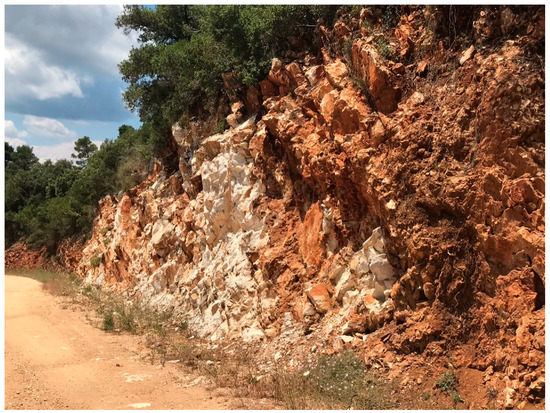
Figure 3.
The stone deposit in a road-cut below Papa Konaki (provided photos taken by the author).
The mentioned construction measures and the materials used in the restoration, for the purpose of improving the energy efficiency of these buildings (Figure 4), have reversible characteristics, which means that the original condition of the restored buildings can be reestablished without causing any structural damage [26].

Figure 4.
The Haybarn Complex (after the restoration).
In no way should energy efficiency measures change the visual identity of the heritage building and its environment. The concept of sustainability can be achieved through the preservation of buildings, as authentic architectural heritage, and their original function or a new one, along with the improved comfort and energy saving. The restoration of historic buildings and the concept of sustainability are inextricably linked.
Sustainable construction and restoration are basic requirements for heritage building preservation:
- The use of authentic construction materials in restoration and interventions as well as the use of construction materials that are not harmful to the property and its environment,
- Energy efficiency of buildings,
- Waste management during the construction and demolition procedures, and potential re-use of waste materials.
3.2. Mineralogical-petrographic Analysis of the Samples of the Stone Used in the Haybarn Complex
Leica DMLSP Polarizing Light Microscope and Leica DFC290 HD digital cameras were used for mineralogical and petrographical analysis. These tests were carried out in the laboratory of the Faculty of Mining and Geology of the University of Belgrade.
The stone outer walls of the Haybarn Complex were built from solid and schistose marble. Sample 1 was taken from the source/ledge near the road in the immediate vicinity of the Monastery (Figure 1). It was established through petrographic analysis that it was formed from densely packed carbonate grains of platelet habitus (Figure 5). In some parts of the sample, it was observed that the rock mass was permeated with post-metamorphic calcite veins. This marble contains a detrital component in the form of very fine grains of quartz and mica, as well.
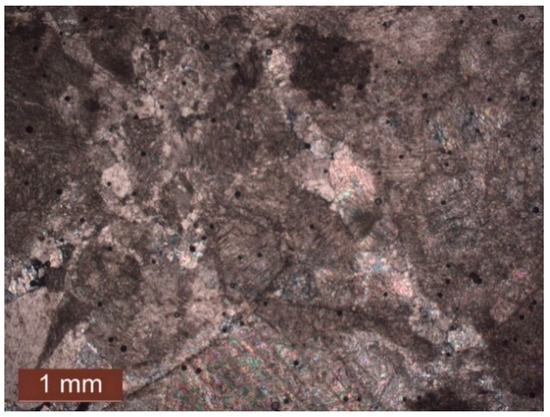
Figure 5.
The photomicrograph of sample 1—massive marble; crossed nichols.
Sample 2 is a schistose marble taken from the source/ledge along the road in the immediate vicinity of the Monastery, 50 m from where sample 1 had been taken (Figure 1). It was established through the petrographic analysis of sample 2 that it was formed from convex carbonate grains which by their elongation define the schistose structure of the rock and fine-grained matrix (Figure 6). This marble contains slightly less detrital components compared to the previously described one.
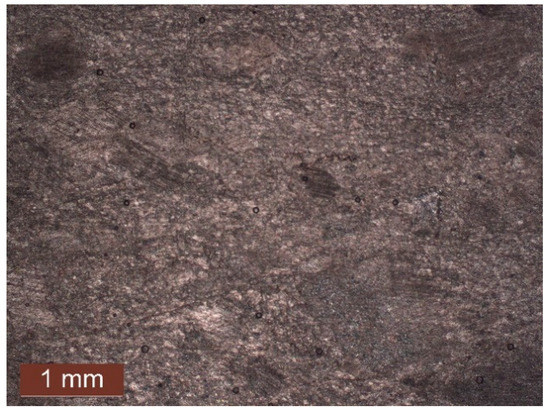
Figure 6.
The photomicrograph of sample 2 rock, schistose marble.
Most of the roofs of the monastery’s buildings were covered with traditionally dark-gray plates/slabs. In the petrographic analysis of sample 3 from the remains of stone slabs taken from the collapsed roof of the Haybarn complex during reconstruction, it was concluded that sample 3 represents a schistose marble containing up to 15% volume of mica.
This rock belongs to the schistose marble series, as well. The nature of its schistosity is so different because the carbonate protolith has most likely had the most detrital components, predominantly represented by mica and clay. During metamorphism, there was a growth of mica, which together with the recrystallized carbonate defined the schistose structure of the rock (Figure 7). Therefore, by the point of view of textural characteristics, the rock looks like half schistose marble, and half mica schist.
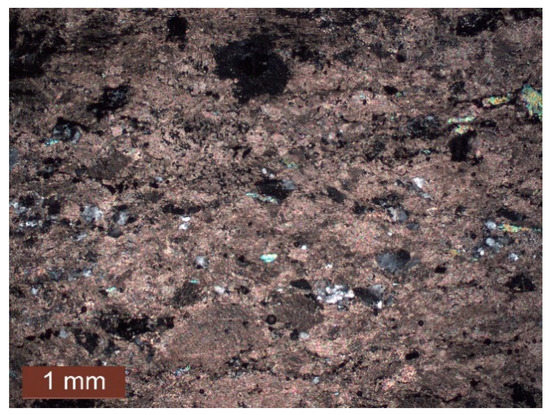
Figure 7.
The photomicrograph structure of sample 3 rock, schistose marble.
During the restoration of the Haybarn Complex, carried out in 2005 and 2006, the old stone covering, made of laminated marble that contained much of mica, was used, and the damaged tiles were replaced with new, stone tiles of the same sizes. The alternate pattern was applied for the installation of an old and new roofing, in order to achieve the visual harmony of the roof plane.
The new stone tiles used for the restoration of the complex are known as Kavala Grey.
The petrographic analysis of sample 4, taken from this new roof slab, has established that the stone type is an epidotic gneiss-micachist (the old geological name leptinolite), which most likely originates from the Serbo-Macedonian mass. The rock has a lepidoblastic and granoblastic texture and schistose to augen structure. It is formed from more than 85–90% quartz, mica, feldspar and epidote, and the rest consists of chlorite, calcite, sphene, apatite, tourmaline, zircon and iron oxides and hydroxides. Figure 8 shows photomicrographs depicting one thicker stripe which is transformed into a lens formed by quartz and plagioclase, surrounded by a matrix of elongated muscovite lamina and quartz lenses. This is the general appearance of the rock, although some millimeter-thick stripes appear, which are only formed from quartz. In Figure 8 with parallel nichols, there are several epidote porphyroblasts that stand out with a high relief.
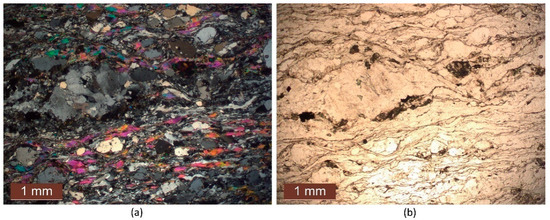
Figure 8.
The photomicrograph structure of sample 4 rock, epidotic: gneiss-micaschist: (a) With crossed nichols, (b) With parallel nichols.
Based on the analysis of scientific literature data and on the mineralogical-petrographic analysis of the four samples from the field, several observations were drawn:
- The area of the Monastery’s property is dominated by the granite group and gneiss group of rocks, while the eastern border (closer to the Monastery) is dominated by the rocks of the ophiolitic mélange group,
- Marbles are widespread and are represented by the following varieties: massive marble, schistose marble, pronouncedly schistose marble, and fine-grained marble. The following granite varieties have been identified: coarse-grained granite, granitoid (quartz/monzonite/diorite) and milonitizedgranitoid,
- The performed baseline studies on the Monastery’s property have shown that the construction stones are very common and that it is most likely used as construction material, but the quarries are no longer discernible in the relief; no written information has been identified,
- As for the restoration of the Haybarn Complex, the installation of a partially new roof covering instead of old, deteriorated and demolished stone tiles, is a partial use of another type of stone that does not belong to the Mount Athos area, which is a novelty of the multi-century practice. The novelty does not affect the visual quality of these buildings.
3.2.1. The Use of Stone as a Roofing Material
The roofs of the compound building of the Haybarn Complex were constructed by laying smaller stone slabs, densely packed, over the vaults or slope roofs. The main binding material was mud mortar, lime mortar or lime mortar mixed with Santorini earth (natural porcelain). The slabs are laid almost horizontally, to a slight fall toward the outer edge in order to allow water drainage. The upper slabs are laid over the joints of the lower layered slabs. This slight slope prevented water intrusion. The stone used as a roofing material had to be compact, dense and easy to be cut to shape, in terms of the slabs 2 to 3 cm thick. This stone type is laminated marble called slate. It is usually a grey stone, which is easy to be cut into slabs. Slate has been used a lot as a roofing material since it is generally known as a long-lasting material, easily cut into slabs. This explains its widespread use for coating flat and slope surface: vaults, arches and cupolas.
The stone slabs were laid over the chestnut sheathing, installed over the wooden roof structure which resisted heavy load due to the weight of the used stone. This roof structure had to be strong enough to resist such a heavy roof cover that weighs from 300 to 500 kg/m2 [27].
Since the monastery is situated on the peninsula of Athos in the Aegean Sea, the strong winds are blowing from the sea and the humidity they bring along penetrated deep through the walls and vaults of these buildings. In most cases, the stone slabs were not resistant to the penetration of rain and humidity in the winter months. Therefore, it was a call for additional reconstruction measures.
3.2.2. Modern Principles of Double-skin Ventilated Roofs and Stone Slate Roofing
It is possible to keep the slate roofing, as an authentic roofing structure, and visual identity of the heritage buildings, if the following modern principles of double-skin ventilated roofs are applied [6]: ventilation of roof space and ventilation of stone-coated roof (above the waterproof layer), i.e., the condensation drying [28] that occurs on the lower sides of the stone slabs at dawn, as well as drying out the moisture that is the result of water penetration between the stone slabs.
The roof restoration was the process of applying the layers of roof coating, according to the building engineering physics, as presented in Figure 9.
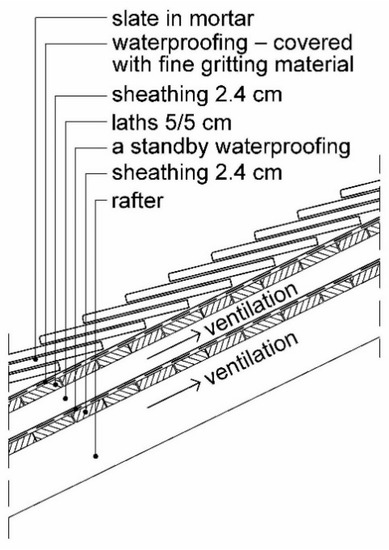
Figure 9.
Recommended restoration of the slate roof covering—the applying of the double ventilation modern principles.
The use of stone for the building roofs starts at the eaves, thus enabling the penetration of air and interrupted airflow between the wooden slats, parallel to the eaves. The installation of ridge vents is required as well (Figure 10).
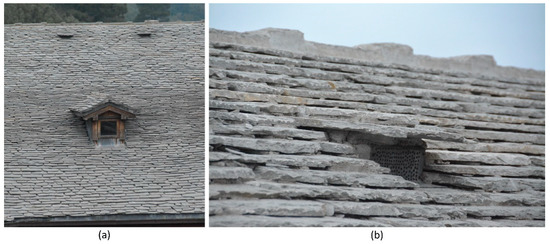
Figure 10.
Venting during the restoration of the slate roofing: (a) roof appearance, (b) roof air vent (the photo taken by the author).
The implementation of modern principles of double-skin ventilated roofs, along with the slate roof covering, ensures a successful restoration of priceless medieval heritage buildings, contributing to the overall world cultural heritage. The use of stone slabs as a roofing material and a double-ventilated roof was first carried out in the area in May 2005, in the restoration of the buildings of the Haybarn Complex [6,29].
3.3. The Research Findings
All three devastated auxiliary buildings of the Haybarn Complex: Mulekeepers’ House, Stable, and Haybarn, are massive masonry buildings, with load-bearing masonry walls made of stone, timber roofs and stone roof coverings. All the external walls were made of rubble and roughly dressed stone made of laminated marble.
The case studies regarding energy efficiency improvements of these historic buildings as well as energy retrofit via Building Performance Simulation (BPS) method, were published as journal articles [4,30].
3.3.1. Restoration of the Stable
The Stable is a single-story building. At a time when the building was first erected, it was connected to the ground floor of the Mulekeepers’ House and animals were kept there [26]. The façade peripheral walls were made of rubble and roughly dressed stone (case 1). The roof above the peripheral walls was made by timber roof truss: joists, columns, bracing and rafters. Ridge tiles were used for roofing. Dormers were set on the roof. Considering the original function of these buildings, the window openings were scarce, since there was no need for natural light. The original windows were single glazed wooden windows. The window openings were narrow, 50–60cm inside width and 20cm external width, in order to prevent daylight penetration and protect donkeys from vision loss, i.e., the so-called donkey blindness.
The original condition of the building (Figure 2a) and its function could not have been classified into energy classes according to the Regulations on energy efficiency of buildings. If the Stable had been used for accommodating people, along with the applying hygiene measures only, it would not have accomplished the requirements of the regulations (Table 1, case 1).

Table 1.
Comparative review of upgrading the sheathing elements in terms of thermal protection and energy reducing on the annual basis, for the two analyzed cases of The Stable.
During the 2005 and 2006 restoration (case 2), the visual quality of the façade walls remained the same and visible stone coating was used for both external and internal walls (Figure 2). The floor restoration was performed on the ground and thermal insulation was added. The restoration of the Stable is significant because the exceptional timber framing of this building remained as it had been before. It was the interior part of the sleeping area for visitors (Figure 2c). New thermal insulation layers were placed over the timber frame structure of the roof. The authentic roofing was made of ridge tiles. The fenestration elements on the façade walls were kept unchanged and the roof dormers were built where they used to be, thus preserving the authentic appearance of the building. The windows were replaced with new 9cm double-glazed wooden frames, and double-glazed, Low-E Glass (4+12+4mm) filled with krypton. Krypton is an inert gas that is used to fill the space between glass panels in order to increase thermal performance and reduce heat loss. The front door was replaced with a new, solid wood door. The structural elements of the building preserved the authentic value after the restoration (Table 1, case 2). The only change was the building’s new function. The visual quality of both interior and exterior elements was preserved according to the buildings conservation best practices Nowadays, the restored Stable contains a spacious bedroom for visitors, sanitary facilities and a laundry. The underfloor heating was also installed.
A comparative review for the two analyzed cases of the Stable shows the effects of the restoration and energy efficiency improvement on heat energy reduction on the annual basis (Table 1).
3.3.2. The Restoration of the Mulekeeper’s House
This building consists of a ground floor and first floor. The ground floor, where the animals were kept, used to be connected to the Stable. The first floor accommodated the mulekeepers. In the winter months, the body temperature of the animals would keep the room and the first floor heated. This was one of the efficient uses of all energy resources a few centuries ago.
All exterior walls were made of rubble and roughly dressed stone [26]. The peripheral walls of the ground floor were coated with visible stone (case 1). The first floor interior walls were all plastered. The original wood windows were single glazed. If this building had been used to accommodate people, along with the applied hygiene measures, (Table 2, case 1), it would not have accomplished the requirements of the stated Regulations on energy efficiency of buildings.

Table 2.
Comparative review of upgrading the sheathing elements in terms of thermal protection and heating energy reducing on the annual basis, for the two analyzed cases of The Mulekeepers’ House.
The 2005 and 2006 restoration of the Mulekeepers’ House (case 2) maintained the authenticity of its façade walls. The stone coating was used for both external and internal ground floor walls (Figure 2b). Since the first floor façade walls were plastered, thermal insulation was added to the existing façade wall from the inside (Table 2, case 2). As for the ground floor, the floor was restored and thermally insulated. The joists between storeys were kept. However, new fillings and authentic coating were applied. Above the first floor, toward the attic area, the thermal insulation and coating were added. The stone coating as an authentic roof covering was carried out in accordance with the modern requirements of ventilated roofs.
During the restoration, the old windows were replaced with new wooden windows, having 9cm thick, double-glazed Low-E Glass (4+12+4mm) filled with krypton gas. The front door was also replaced with a new, solid wood door.
Today, the ground floor of the restored Mulekeepers’ House consists of a sitting room, a kitchenette, and a sanitary block. The first floor consists of a smaller sitting room, three bedrooms, and a sanitary block. Underfloor heating was installed on the ground floor and low-temperature radiators were added to the first floor.
The comparative review for the two analyzed cases of the Mulekeepers’ House shows the effects of the restoration and energy efficiency improvement on heat energy reduction on the annual basis (Table 2).
3.3.3. The Restoration of the Haybarn
The Haybarn was a very tall building used for hay storage (case 1). The exceptionally high peripheral walls were made of rubble and roughly dressed stone. The building had the stone coated façade and stone slab roof (Figure 2a). The original appearance and function of this building could not be classified into energy classes according to the regulations on energy efficiency. If the purpose of the building had been to accommodate people, applying the hygiene measures only (Table 3, case 1), it could never have met the requirements of the stated Regulations on energy efficiency of buildings.

Table 3.
Comparative review of upgrading the sheathing elements in terms of thermal protection and heating energy reducing on the annual basis, in the analyzed cases of The Haybarn.
During the restoration, the entire space was horizontally divided into three floors by two intermediate floor structures (case 2). All the façade walls were thermally insulated from the inside [26]. The floor of the ground floor was restored and thermally insulated (Table 3, case 2). Thermal insulation was set between the joists, above the top floor, toward the attic area. The wooden framed windows, 9cm thick, with double-glazing and Low–E Glass (4+12+4mm) filled with krypton were installed. The front door was replaced with a new, solid wood door. The roof structure with timber trusses and stone roofing were built according to the modern requirements of ventilated roofs, in the same way as it was done in the Mulekeepers’ House. The authentic appearance of the building was completely preserved in terms of building materials, stone coated facades, wooden frames, roof coating as well as the height, structure, and shape of the roof (Figure 2b). Traditional radiator heating was also installed in the entire building. After the restoration, the building was turned into a dormitory for visitors. The restored three-storey building consists of bedrooms and sanitary facilities.
The comparative review of the two analyzed cases of the Haybarn shows the effects of the restoration and energy efficiency improvement on heat energy reduction on the annual basis (Table 3).
3.4. Recommendations for Improving Energy Efficiency During the Restoration of Historic Buildings for the Purpose of their Adaptive Re-Use
In order to improve the energy efficiency of heritage buildings, it is recommended to implement all the conservation requirements and the following specific measures:
- Adequate thermal insulation of the building envelope,
- Heat loss reduction,
- Energy efficient systems of cooling, heating, and ventilation, with the use of alternative renewable energy sources.
Based on the conservation requirements, in order to maintain the authentic characteristics of historic buildings, their architectural value and their structure, the standard thermal insulation is not recommended for the external façade walls and neither changing external elements that could diminish the concept of authenticity.
In order to ensure the re-use and the sustainable energy retrofit for the restored historic buildings of the Haybarn Complex, the following energy efficiency measures were recommended and carried out:
- Thermal insulation of façade walls, only at the inside,
- Thermal insulation of floors on the ground floor,
- Thermal insulation of the mezzanine structure toward the unheated attic,
- Thermal insulation of the roof layers above the attic area that is being used, or above the attic area integrated into stores,
- Replacement of façade joinery (windows and front doors),
- New heating and cooling systems, along with the use of renewable energy sources and the applying of the environmental protection requirements,
- Energy efficiency management.
As for the cases where the façade walls were thermally insulated from the inside, it was important to implement additional fire protection measures and prevent the following potential defects: thermal bridge and water vapor diffusion (condensation). All the mentioned construction methods and techniques applied during the restoration aimed to improve the energy performance of the buildings.
Meeting the energy efficiency requirements and carrying out the energy efficiency improvement plans ensure energy saving for this isolated site. Along with the conducted analysis related to the existing conditions on the Mount Athos area and with the decisions on implementing of adequate measures for improving thermal performance, it was necessary to improve energy performance in heating systems as well, according to the environmental protection requirements of the Mount Athos area. Two heat-distribution systems were applied in the complex: radiators and water-based underfloor heating. Wood-fired boilers are also used. The heat distribution system and the use of wood are environmentally friendly choices, in accordance with the requirements for reducing the greenhouse gas emission. The wood is a renewable and sustainable material. Since the Hilandar Monastery is situated in a large forested area, all the required amounts of wood are obtained by their own trees; this fact contributes to a significant cost-reducing, which also enables local access to energy sources in this remoted site, knowing that boats are the only means of transport.
Today, diesel equipment is supplying energy for this area. Energy generating products are delivered by boats. Other studies dealt with the analysis of using solar energy in this area in order to provide energy supply by implementing PV panels in the future [4].
4. Discussion
The main condition that has guided the restoration of the Haybarn Complex was the maintenance of the original architectural character as much as possible, along with the preservation of the authentic integrity of the buildings. At the same time, attention was paid to keep the distinctive architectural elements and decorative features that reflect the historical period and the construction phases, according to the environmental characteristics of the monastery property.
The presented research is a part of the energy retrofit analysis and the restoration of the Haybarn Complex [4,30]. The study provides potential and practical solutions for energy refurbishment and/or energy retrofitting of historic buildings in the case studies.
The analysis of the presented cases of the Haybarn Complex: the building originally built in the first half of the 19th century and the building restored during 2005 and 2006, including the energy efficiency improvement measures, leads to the conclusion that maximum thermal insulation, added to the building envelope elements in accordance with the conservation requirements in order to preserve the authenticity and stone-coated facades, it is possible to achieve a significant level of energy saving.
Based on a comparative review of the obtained values for the overall heat loss for all the three analyzed buildings: the Mulekeepers’ House, the Stable and the Haybarn Complex, in both analyzed cases: (a) the building before the restoration (the condition from the 19th century), and (b) the building restored during 2005 and 2006, for the purpose of heat loss reduction, we found that heat energy consumption was reduced on the annual basis. This analysis and the Energy Efficiency Passport for both analyzed cases of the Haybarn Complex ensured the energy classification of the buildings in accordance with the Regulations on the energy efficiency of buildings (Table 1, Table 2 and Table 3).
The analysis and evaluation of these historic buildings in terms of the performed restoration of the Haybarn Complex, along with applying the recommended energy efficiency improvement measures in accordance with the conservation requirements, the authors presented the key findings that have never been evaluated in this way in the scientific literature. The authors of this study drew valid conclusions on the basis of real values and the results regarding energy saving, after having obtained the thermal insulation measures, according to the conservation requirements and the principles of environmental protection of the site.
The research findings were provided by on-site observation, along with the methods of valorization of the Haybarn Complex and energy saving analysis for each case. The research has also confirmed that it is possible to obtain energy saving and improving of energy efficiency during the restoration of historic buildings if adequate construction technology is applied according to the conservation requirements for the preserving of the authenticity. All these measures are implemented in order to restore and revitalize the buildings as well as to maintain the authentic values of the heritage site.
Although the restoration from 2005 and 2006 improved the energy performance of the Stable, the building remained in the energy class ″G″ (Table 1). This study confirms that a large area of peripheral walls is part of the external building envelope that has a big impact on heat loss; this explains why the applied thermal insulation measures failed to improve the energy efficiency of the building.
The Mulekeepers’ House is the only building that could have been classified into energy class ″G″ at the very beginning, considering the original function of the 19th century building (Table 2). After the restoration had carried out in 2005 and 2006, along with the applied measures for improving energy efficiency, the evaluated energy performance of this building was increased by two classes, from energy class ″G″ to energy class ″E″. This improvement is the result of the thermal insulation added to the peripheral surface, from the inside of the façade walls on the first floor as well as above the top floor toward the attic. Meanwhile, the façade walls on the ground floor maintained its authentic appearance—the stone coated the internal and external sides of the façade walls.
The 2005 and 2006 restoration improved the energy efficiency of the Haybarn building. The applied construction measures turned its energy class ″G″ into energy class ″C″ and the restored building was finally energy efficient (Table 3). The energy efficiency was achieved by upgrading all the peripheral areas of the building in terms of thermal insulation on the interior façade walls as well as above the top floor toward the attic.
The hypotheses were tested by on-site observation and valorization of each building of the Haybarn Complex, in terms of energy saving and energy efficiency, in accordance with the conservation requirements. The obtained results support the hypothesis regarding the use of stone, extracted from the local quarry, as an authentic building material used for façade restoration, and the use of slate for roofing. This approach is the only appropriate choice of building materials for the restoration of massive walls and the use of stone as a roofing material on this isolated heritage site. The hypothesis concerning the implementation of adequate construction measures, in accordance with the conservation requirements and authenticity maintenance, was confirmed. The hypothesis about the potential restoration of the devastated buildings and re-use of the building, for the purpose of revitalization and authenticity maintenance, was also tested and confirmed through on-site observations. The research findings confirmed the hypothesis that the restoration of the devastated building could ensure energy saving and contribute to the energy performance of the building.
The research findings confirmed the assertion made by Bionaz [12], since the energy performance of ancient buildings turned out to be underestimated, it led to overestimated interventions aimed to achieve the required standards in accordance with the regulations.
The analysis of the Haybarn Complex and its re-use confirmed the assertion made by Plevoets and Cleempoel [7], historic buildings and their adaptive re-use prove the importance of the intervention for the conservation of cultural heritage.
Adaptive re-use of the Haybarn Complex confirmed the assertion made by Mısırlısoy and Günçe [1], that the most appropriate adaptive re-use strategy has a vital importance for heritage building conservation and maintenance of cultural, economic and social values. The authors of this study concluded the same as Mısırlısoy and Günçe [5] that the materials used for restoration should be in harmony with the original materials and in accordance with the structural integrity of the building and space demands of new function activities.
The assertion made by Murgul was also confirmed [11]. It is reasonable to protect the visual quality of the historic environment along with the unique and environmentally sustainable historic construction, tested by century-long working experiences.
This study once again confirms the significance of identifying and preventing all negative effects on heritage buildings, knowing that performed restoration and energy efficiency of historic buildings can be successfully achieved only without any negative impact on historic character and integrity of these buildings, which confirms the research conducted by Hensley and Aguilar [9]. After the restoration of these buildings and their adaptive re-use, the process of constant observation continued in order to detect any failure or imperfection in terms of condensation, mold or inadequate thermal comfort. It is of vital importance to pay close attention to the mentioned occurrences in order to prevent any irreparable damage to historic buildings and their architecture. This study led to the same conclusions as to the ones presented by Hensley and Aguilar [8] regarding the need for regular maintenance of historic buildings, monitoring and observation of the restored buildings during the carrying out of their new function, and the implementation of long-term protection measures aimed to conserve their historic character.
This study led to the same conclusions as the ones made by Bionaz [12] regarding the restoration of historic buildings having massive stone walls: the interventions in terms of window replacement and shade installation will fail to meet the modern living requirements in terms of thermal comfort and energy efficiency, unless all the peripheral stone walls are thermally insulated from the inside.
The assertion of Martin & Carlos was also confirmed [10] the heritage building can be preserved if retrofitting is carried out in the interior of that building, along with keeping the original aspects of exterior walls.
Once again this research confirms the conclusion made by Todorovic et al. [3] that the dominant characteristic of heritage buildings is bioclimatic design, carefully planned architectural structure and appropriate choice of construction materials, whose endurance and durability performances are tested and measured by the hundreds of years, reflecting their sustainability.
The study once again points out the importance of appropriate analysis of all the aspects that can negatively affect the heritage building during the restoration, keep in mind that energy efficiency of a historic building can be optimal only without any negative effects on architectural character and integrity, which confirms the research findings formulated by Hensley and Aguilar [8].
What makes this study innovative in comparison to other authors is the unique model of the restoration of the auxiliary Haybarn facilities, aimed to carry out retrofitting and adaptive re-use in terms of accommodations for monastery visitors. This study analyzed the principles and measures of energy efficiency for the purpose of energy refurbishment of the heritage building, since it was one of the first restorations of this type that was carried out on Mount Athos, thus proving the professional value and scientific argumentation in relation to practical use of it and to potential applying on other similar heritage sites. All the analyzed cases of the Haybarn Complex were designed and realized following the energy efficiency principles. The research was tested directly through the practical implementation of the secluded and ecological area of Mount Athos, which is regarded as its greatest achievement [31]. The objective of further research in this field is to analyze the possibilities of energy saving in historic buildings, using extensive reconstruction measures included in a large-scale construction project.
5. Conclusions
The need for additional accommodation for a growing number of Hilandar Monastery visitors led to the restoration and revitalization of the damaged buildings of the Haybarn, turning them into lodgings. The creation of the Haybarn Complex linked cultural heritage to modern social changes.
The restoration and adaptive re-use of heritage buildings, along with the implementation of energy efficiency measures, requires an individual approach to each historic building. The main contribution of this study is data analysis and interpretation of the research findings in order to determine retrofitting potentials by implementing energy efficiency measures in the selected heritage buildings, in accordance with the conservation requirements, the preservation of the authentic character and integrity of the Haybarn Complex and the use of stone as an authentic material extracted from the local quarry, thus maintaining the authenticity of the entire heritage site. The research findings could be used for choosing adequate sites to supply the construction stone for the purpose of restorations.
One of the main postulates of heritage conservation is the use of natural resources as authentic materials for restoration and reconstruction. In order to achieve energy saving, according to the conservation requirements, the following construction measures are to be considered and carefully planned: (a) the building insulation and (b) replacement and installation of adequate windows and doors. The mentioned measures and the use of renewable energy sources in order to enable annual energy supply can significantly improve the energy performance of historic buildings.
The restoration of heritage buildings, for the purpose of their adaptive re-use and energy efficiency improvement, should include the following actions:
- Thorough assessment of a building conditions, along with determining the level and type of required restoration, based on the building condition,
- Selection of construction measures to be applied during energy retrofitting and adaptive re-use, in accordance with the conservation requirements,
- Selection of adequate authentic material for walls and roofing (in this case – it is stone), following the conservation requirements and local resources availability—the quarries from where the stone used to be extracted centuries ago,
- Selection of energy refurbishment and/or energy retrofitting interventions for the purpose of re-use, in accordance with the conservation requirements,
- Selection of adequate methods for using renewable energy sources in order to enable annual energy supply, for the purpose of achieving energy saving and ensuring environmental protection of this remote area of Mount Athos, as included in the concept of energy management.
It can be concluded that restoration, reconstruction, and revitalization of heritage buildings, along with the implementation of energy efficiency measures, are regarded as reversible and requires an individual approach to each historic building. In order to achieve energy saving and to reduce heat loss, it is necessary to add thermal insulation on the building envelope, following the requirements of the conservations, since it is the only way to improve the energy performance of historic buildings. All the measures of energy refurbishment and/or energy retrofitting were implemented in a case study at Haybarn Complex in accordance with technical and ethical conservation requirements. The main contribution of this paper is the analysis of the energy refurbishment results, in terms of adaptive re-use, achieved by implementing the energy efficiency measures in the restoration of heritage buildings, according to the concept of maintaining the authenticity for the visual characteristics.
Author Contributions
All authors contributed equally to this paper. Conceptualization and methodology, N.Š., N.D.R, and J.I.-Š.; validation, investigation, N.Š., N.D.R, V.C., D.M., S.B. and J.I.-Š.; writing-original draft preparation: N.Š., N.D.R, D.M, V.C., S.B, and J.I.-Š.; writing-review & editing N.Š., N.D.R, and J.I.-Š. All authors read and approved the final manuscript.
Funding
This paper was written as a part of the projects “Spatial, Environmental, Energy and Social Aspects of Development of Settlements and Climate Change”, under the Grant number (TR 36035) financed by the Ministry of Education and Science of the Republic of Serbia for the period 2011–2019.
Acknowledgments
The authors would like to thank Brkić Milan, Geological Engineer, Geoprofesional d.o.o., Belgrade, Serbia, for technical support.
Conflicts of Interest
The authors declare no conflict of interest.
References
- Mısırlısoy, D.; Günçe, K. Adaptive reuse strategies for heritage buildings: A holistic approach. Sustain. Cities Soc. 2016, 26, 91–98. [Google Scholar]
- Stratton, M. Industrial Buildings: Conservation and Regeneration; Taylor & Francis: London, UK, 2003. [Google Scholar]
- Todorović, M.S.; Ećim-Đurić, O.; Nikolić, S.; Ristić, S.; Polić-Radovanović, S. Historic building’s holistic and sustainable deep energy refurbishment via BPS, energy efficiency and renewable energy—A case study. Energy Build. 2015, 95, 130–137. [Google Scholar]
- Šekularac, N.D.; Šumarac, D.M.; Čikić Tovarović, J.L.; Čokić, M.M.; Ivanović-Šekularac, J.A. Re-use of historic buildings and energy refurbishment analysis via building performance simulation: A case study. Therm. Sci. 2018, 22, 2335–2354. [Google Scholar]
- Günçe, K.; Mısırlısoy, D. Assessment of Adaptive Reuse Practices through User Experiences: Traditional Houses in the Walled City of Nicosia. Sustainability 2019, 11, 540. [Google Scholar]
- Sekularac, N.; Sekularac, J.I.; Tovarovic, J.C. Application of Stone as a Roofing in the Reconstruction and Construction. J.Civ. Eng. Archit. 2012, 6, 919. [Google Scholar]
- Plevoets, B.; Van Cleempoel, K. Adaptive Reuse as a Strategy towards Conservation of Cultural Heritage: A Survey of 19th and 20th Century Theories. 2012. Available online: https://pdfs.semanticscholar.org/ee88/eefed42e089e3cea99d8c6fa41d523c74a3f.pdf (accessed on 29 May 2012).
- Hensley, J.E.; Aguilar, A. Improving Energy Efficiency in Historic Buildings; Government Printing Office: Washington, DC, USA, 2012; Volume 3.
- ICOMOS, N. The Nara Document on Authenticity. In Proceedings of the ICOMOS, Nara, Japan, 1–6 November 1994. [Google Scholar]
- Martins, A.M.; Carlos, J.S. The retrofitting of the Bernardas’ Convent in Lisbon. Energy Build. 2014, 68, 396–402. [Google Scholar]
- Murgul, V. Features of energy efficient upgrade of historic buildings: Illustrated with the example of Saint-Petersburg. J. Appl. Eng. Sci. 2014, 12, 1–10. [Google Scholar]
- Bionaz, C. Preservation and Energy Behavior in Aosta Valley’s Traditional Buildings. In Proceedings of the VerSus 2014, International Conference on Vernacular Heritage, Sustainability and Earthen Architecture, Valencia, Spain, 11–13 September 2014. [Google Scholar]
- Mazzarella, L. Energy retrofit of historic and existing buildings. The legislative and regulatory point of view. Energy Build. 2015, 95, 23–31. [Google Scholar]
- Srbija, R. Ministarstvo životne sredine, rudarstva i prostornog planiranja (Minister of Environment, Mining and Spatial Planning), Pravilnik o energetskoj efikasnosti zgrada (Regulations on Energy Efficiency of Buildings - Rulebook on energy efficiency of buildings); Official Gazette of the Republic of Serbia: Belgrade, Serbia, 2011; pp. 61–2011.
- Srbija, R. Ministarstvo životne sredine, rudarstva i prostornog planiranja (Minister of Environment, Mining and Spatial Planning), Pravilnik o uslovima, sadržini i načinu izdavanja sertifikata o energetskim svojstvima zgrada (Regulations on Conditions, Contents, and Methods of Certificate Issuance regarding energy efficiency of buildings); Official Gazette of the Republic of Serbia: Belgrade, Serbia, 2012.
- Parliament, E. Directive 2002/91/EC of the European Parliament and of the Council of 16 December 2002 on the energy performance of buildings. Off. J. Eur. Communities 2003, 1, 65–71. [Google Scholar]
- Recast, E. Directive 2010/31/EU of the European Parliament and of the Council of 19 May 2010 on the energy performance of buildings (recast). Off. Eur. Union 2010, 18, 2010. [Google Scholar]
- Ivanović-Šekularac, J.; Čikić-Tovarović, J.; Šekularac, N. Application of wood as an element of façade cladding in construction and reconstruction of architectural objects to improve their energy efficiency. Energy Build. 2016, 115, 85–93. [Google Scholar]
- Bogdanović, D. Hilandar; Republički zavod za zaštitu spomenika kulture Srbije: Belgrade, Serbia, 1978; p. 36.
- Trifunović, Đ.B.; Bjelogrlić, V.; Brajović, I. Hilandarska osnivačka povelja Svetoga Simeona i Svetoga Save. In Osam Vekova Studenice; Episkop žički Stefan, A.J., Kašić, D., Eds.; Sveti arhijerejski sinod Srpske pravoslavne crkve: Belgrade, Serbia, 1986; pp. 194–212. [Google Scholar]
- Dimitrijević, M.D. Srpsko-makedonska masa. In Geologija Jugoslavije; Geoinstitut & Barex: Belgrade, Serbia, 1995; pp. 115–126. [Google Scholar]
- Himmerkus, F.; Zachariadis, P.; Reischmann, T.; Kostopoulos, D. The basement of the Mount Athos peninsula, northern Greece: insights from geochemistry and zircon ages. Int. J. Earth Sci. 2012, 101, 1467–1485. [Google Scholar]
- Kochel, F.; Mollat, H.; Antoniades, P. Geological Map of Greece, 1:50.000, Ierissos Sheet; Institute of Geology and Mineral Exploration (IGME): Athens, Greece, 1968. [Google Scholar]
- Nenadović, S. Osam Vekova Hilandara—Građenje i Građevine; Republički zavod za zaštitu spomenika kulture: Belgrade, Serbia, 1997.
- Ivanović-Šekularac, J.; Čikić-Tovarović, J.; Šekularac, N. Reconstruction and revitalization of the Complex Senara, within the monastery Hilandar, in order to adapt to modern trends and social changes. In Keeping up with Technologies to Make Healthy Places; Faculty of Architecture: Ljubljana, Slovenia, 2015. [Google Scholar]
- Ivanović-Šekularac, J.; Čikić-Tovarović, J.; Šekularac, N. Restoration and Conversion to Re-use of Historic Buildings Incorporating Increased Energy Efficiency–A Case Study–The haybarn complex, Hilandar Monastery, Mount Athos. Therm. Sci. 2016, 20, 131. [Google Scholar]
- Šekularac, N.; Ivanović-Šekularac, J.; Čikić-Tovarović, J. Application of stone as a roofing in the reconstruction and construction. In Proceedings of the 2nd WTA-International Ph. D. Symposium, Brno University of Technology, Brno, Czech Republic, 6 October 2011. [Google Scholar]
- Fasio, P.; Ge, H.; Rao, J. Urban Building Physics: A CFD study of the Venturi-effect in non-parallel passages between buildings. In Research in Building Physic and Building Engineering; Taylor & Francis: Montreal, QC, Canada, 2006. [Google Scholar]
- Ivanović-Šekularac, J.; Šekularac, N.; Čikić-Tovarović, J. Introduction of Modern Principles of Design in Covering of Roofs with Stone. In Harmony of Nature and Spirituality in Stone; Kamen Srbije: Kragujevac, Serbia, 2012. [Google Scholar]
- Ivanović-Šekularac, J.; Čikić-Tovarović, J.; Čokić, M.; Šekularac, N. Restoration of historic buildings and verification of sustainable energy refurbishment. KGH—Sci. Prof. J. Air Cond. Heat. Refrig. 2016, 45, 49–56. [Google Scholar]
- Lidelöw, S.; Örn, T.; Luciani, A.; Rizzo, A. Energy-efficiency measures for heritage buildings: A literature review. Sustain. Cities Soc. 2018, 45, 231–242. [Google Scholar]
© 2019 by the authors. Licensee MDPI, Basel, Switzerland. This article is an open access article distributed under the terms and conditions of the Creative Commons Attribution (CC BY) license (http://creativecommons.org/licenses/by/4.0/).
